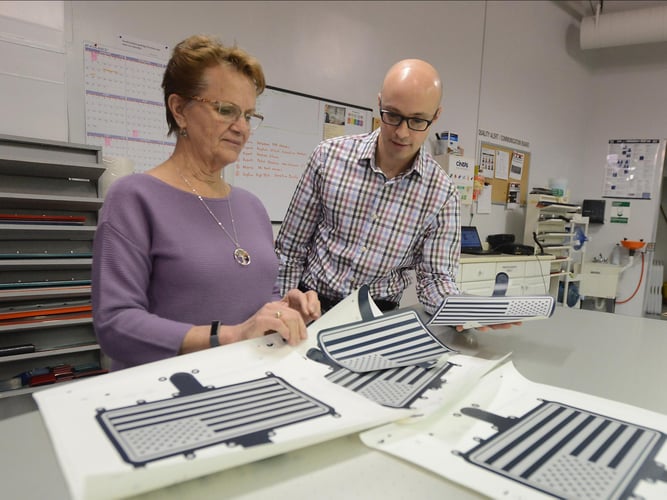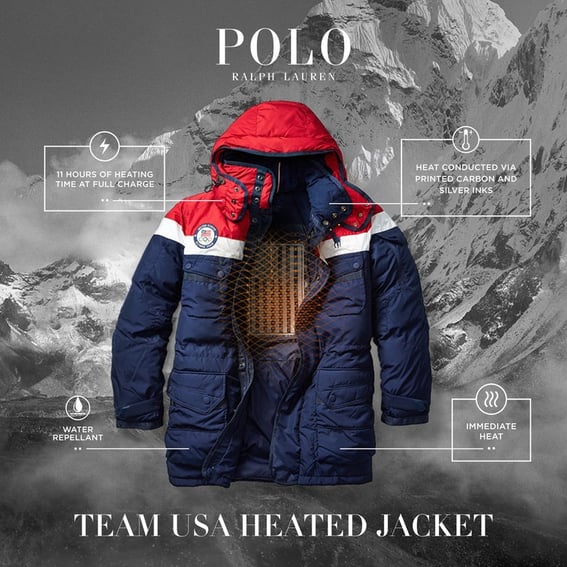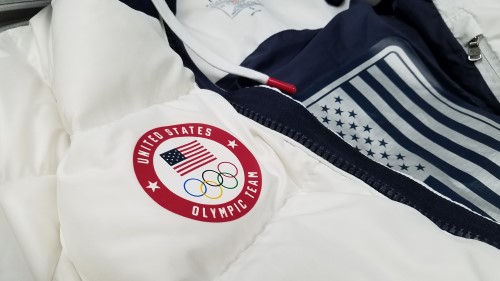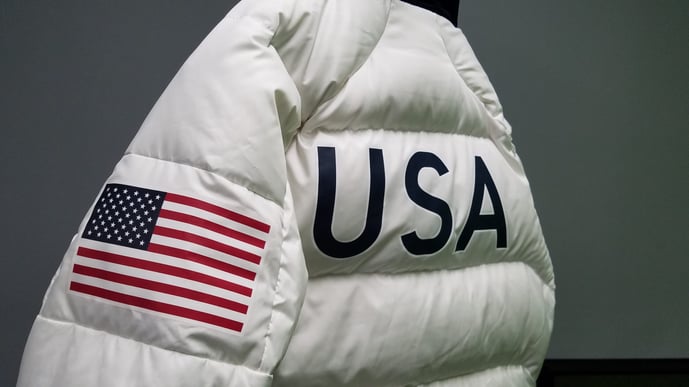It’s not every day that you get to help work on Olympic athletes’ wardrobes.
Butler Technologies, Inc. (BTI)
has worked on exciting projects spanning nearly all industries. One opportunity stands out in particular. In 2018, we collaborated on the Ralph Lauren custom heated parkas worn by Team USA in the opening ceremony at the Olympic Games.
We are proud of our participation in the design and manufacture of flexible, printed heaters incorporated into the jackets.
How We Got Involved with the Development of the Heated Olympic Jackets
Ralph Lauren’s opening ceremony parka was created specifically for the Olympic and Paralympic Winter Games PyeongChang 2018. Ralph Lauren had originally approached our partner and technology giant, DuPont, about heating the jacket.
When DuPont asked BTI to help with the development of the flexible heater portion of the project, we were unaware that the product was for Ralph Lauren. “Not only was it a thrill to be working with RL, but to learn the heater would be incorporated into an Olympic jacket, was such an honor,” said Michael Wagner, COO for BTI, in a 2018 interview with Ralph Lauren Magazine.
Engineering teams from BTI and DuPont worked closely together to create a solution for heating the jackets to keep the Olympians warm no matter how low the temperatures dropped in PyeongChang.
The solution was a flexible, wireless heater, produced just like the printed electronics we create in-house every day. The heater would blend seamlessly inside of the parka, centered on the back panel.
We built additional relationships with other wearable technology companies in the United States who were responsible for supplying materials like the insulated down and the battery connector portions of the project.
How the Heater was Designed
The design steps for this project worked similarly to other projects at BTI. Design, testing, production, and assembly were all performed by our expert team and with collaboration with our partner, DuPont.
The flexible heater was designed using the technology and best practices that we use in all our printed heaters at BTI. With conductive inks such as silver and copper, time-tested layouts, and layers of screen-printing, we tested the optimal layout for a flexible, wireless heater that could be incorporated into the jacket itself. The jacket, once completed, could be heated at three different settings to fit the wearer’s preference, and could last for 11 hours at full charge.
The American flag on the interior back panel provided a functional advantage in addition to aesthetics. With long, vertical stripes, the structured shape allowed for a straightforward pattern for conductive inks and traces to follow, easily hidden behind the bold stars and stripes.
With each unique heater application, our team chooses from a full range of conductive, resistive, and positive temperature coefficient inks, and a range of flexible substrate options, such as polyester (PET), polyimide (PI), Kapton RS Conductive Film, and thermoplastic polyurethanes (TPU). In this case, the team decided to use a Positive Temperature Coefficient (PTC) Heater. This type of heater utilizes silver and carbon inks, where the silver ink serves as a BUS system to transfer heat from the source throughout the rest of the material, and the carbon manages and amplifies the heat at a safe amount thanks to its self-regulating features at the molecular level.
In this case, the team decided to use a Positive Temperature Coefficient (PTC) Heater. This type of heater utilizes silver and carbon inks, where the silver ink serves as a BUS system to transfer heat from the source throughout the rest of the material, and the carbon manages and amplifies the heat at a safe amount thanks to its self-regulating features at the molecular level.
When power is applied, the resistance increases and limits the heater’s electrical current, causing it to cool when it reaches a certain temperature. As the heater then cools, the electrical current will increase once more until it reaches the shutoff point, and the cycle continues. This means that the heater is self-regulating and will never run the risk of overheating or getting too uncomfortably hot when worn.
Designing PTC heaters on PET (polyester) restricts the amount of stretch, preventing any changes in the layout and deposition of the conductive inks, and keeping it working as intended.
The Jacket in Action at the 2018 Olympic Games
Not surprisingly, the Ralph Lauren parka stunned in the 2018 Olympics Opening Ceremony. But even more impressive was the fact that the jacket kept the players warm and toasty despite the frigid temperatures in PyeongChang. The jacket receives compliments to this day from athletes in the 2018 games.
To say we were proud to see our product on the international stage is an understatement. Over the past 30+ years, BTI has transformed from a user interface manufacturing facility to an expert in printed electronics and wearable technology. Located in Butler, PA, we’re proud to be a US-based manufacturer that’s providing innovative, future-proof solutions – like keeping our Olympians warm while they go earn medals for Team USA.

The Future of Wearables is Getting Printed Right Here in Butler, PA
We work on all sorts of custom projects and are proud to be part of manufacturing innovative user interface products that are changing the future for the better. To keep up on our latest projects, follow us on LinkedIn or sign up for our newsletter. If you’re looking to work with us on your next custom printed electronics project, contact our team.
Meet the Author
 Madelyn is an integrated marketing specialist at Butler Technologies and has a passion for problem-solving, project management, and storytelling. She loves marketing in the B2B technology space and has a degree in English specializing in editing, writing and media from Florida State University.
Madelyn is an integrated marketing specialist at Butler Technologies and has a passion for problem-solving, project management, and storytelling. She loves marketing in the B2B technology space and has a degree in English specializing in editing, writing and media from Florida State University.
